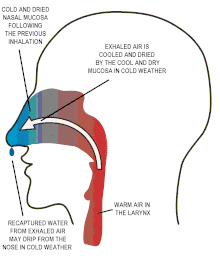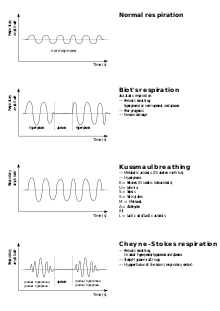Breathing
Breathing (spiration
All
The breathing of all
Breathing has other important functions. It provides a mechanism for
Mechanics
The
During heavy breathing (hyperpnea) as, for instance, during exercise, exhalation is brought about by relaxation of all the muscles of inhalation, (in the same way as at rest), but, in addition, the abdominal muscles, instead of being passive, now contract strongly causing the rib cage to be pulled downwards (front and sides).[8] This not only decreases the size of the rib cage but also pushes the abdominal organs upwards against the diaphragm which consequently bulges deeply into the thorax. The end-exhalatory lung volume is now less air than the resting "functional residual capacity".[8] However, in a normal mammal, the lungs cannot be emptied completely. In an adult human, there is always still at least one liter of residual air left in the lungs after maximum exhalation.[8]
Diaphragmatic breathing causes the abdomen to rhythmically bulge out and fall back. It is, therefore, often referred to as "abdominal breathing". These terms are often used interchangeably because they describe the same action.
When the accessory muscles of inhalation are activated, especially during
Passage of air

Upper airways

Ideally, air is breathed
Lower airways
The anatomy of a typical mammalian respiratory system, below the structures normally listed among the "upper airways" (the nasal cavities, the pharynx, and larynx), is often described as a respiratory tree or tracheobronchial tree (figure on the left). Larger airways give rise to branches that are slightly narrower, but more numerous than the "trunk" airway that gives rise to the branches. The human respiratory tree may consist of, on average, 23 such branchings into progressively smaller airways, while the respiratory tree of the mouse has up to 13 such branchings. Proximal divisions (those closest to the top of the tree, such as the trachea and bronchi) function mainly to transmit air to the lower airways. Later divisions such as the respiratory bronchioles, alveolar ducts and alveoli are specialized for gas exchange.[8][10]
The trachea and the first portions of the main bronchi are outside the lungs. The rest of the "tree" branches within the lungs, and ultimately extends to every part of the lungs.
The alveoli are the blind-ended terminals of the "tree", meaning that any air that enters them has to exit the same way it came. A system such as this creates dead space, a term for the volume of air that fills the airways at the end of inhalation, and is breathed out, unchanged, during the next exhalation, never having reached the alveoli. Similarly, the dead space is filled with alveolar air at the end of exhalation, which is the first air to breathed back into the alveoli during inhalation, before any fresh air which follows after it. The dead space volume of a typical adult human is about 150 ml.
Gas exchange
The primary purpose of breathing is to refresh air in the alveoli so that
Control
The rate and depth of breathing is automatically controlled by the
Automatic breathing can be overridden to a limited extent by simple choice, or to facilitate
Other automatic breathing control reflexes also exist. Submersion, particularly of the face, in cold water, triggers a response called the
Composition
Inhaled air is by volume 78% nitrogen, 20.95% oxygen and small amounts of other gases including argon, carbon dioxide, neon, helium, and hydrogen.[17]
The gas exhaled is 4% to 5% by volume of carbon dioxide, about a 100 fold increase over the inhaled amount. The volume of oxygen is reduced by about a quarter, 4% to 5%, of total air volume. The typical composition is:[18]
- 5.0–6.3% water vapor
- 79% nitrogen [19]
- 13.6–16.0% oxygen
- 4.0–5.3% carbon dioxide
- 1% argon
- parts per million (ppm) of hydrogen, from the metabolic activity of microorganisms in the large intestine.[20][clarification needed]
- ppm of carbon monoxide from degradation of heme proteins.[clarification needed]
- 1 ppm of ammonia.
- Trace many hundreds of
In addition to air, underwater divers practicing technical diving may breathe oxygen-rich, oxygen-depleted or helium-rich breathing gas mixtures. Oxygen and analgesic gases are sometimes given to patients under medical care. The atmosphere in space suits is pure oxygen. However, this is kept at around 20% of Earthbound atmospheric pressure to regulate the rate of inspiration.[citation needed]
Effects of ambient air pressure
Breathing at altitude

Atmospheric pressure decreases with the height above sea level (altitude) and since the alveoli are open to the outside air through the open airways, the pressure in the lungs also decreases at the same rate with altitude. At altitude, a pressure differential is still required to drive air into and out of the lungs as it is at sea level. The mechanism for breathing at altitude is essentially identical to breathing at sea level but with the following differences:
The atmospheric pressure decreases exponentially with altitude, roughly halving with every 5,500 metres (18,000 ft) rise in altitude.[23] The composition of atmospheric air is, however, almost constant below 80 km, as a result of the continuous mixing effect of the weather.[24] The concentration of oxygen in the air (mmols O2 per liter of air) therefore decreases at the same rate as the atmospheric pressure.[24] At sea level, where the ambient pressure is about 100 kPa, oxygen constitutes 21% of the atmosphere and the partial pressure of oxygen (PO2) is 21 kPa (i.e. 21% of 100 kPa). At the summit of Mount Everest, 8,848 metres (29,029 ft), where the total atmospheric pressure is 33.7 kPa, oxygen still constitutes 21% of the atmosphere but its partial pressure is only 7.1 kPa (i.e. 21% of 33.7 kPa = 7.1 kPa).[24] Therefore, a greater volume of air must be inhaled at altitude than at sea level in order to breathe in the same amount of oxygen in a given period.
During inhalation, air is warmed and saturated with water vapor as it passes through the nose and pharynx before it enters the alveoli. The saturated vapor pressure of water is dependent only on temperature; at a body core temperature of 37 °C it is 6.3 kPa (47.0 mmHg), regardless of any other influences, including altitude.[25] Consequently, at sea level, the tracheal air (immediately before the inhaled air enters the alveoli) consists of: water vapor (PH2O = 6.3 kPa), nitrogen (PN2 = 74.0 kPa), oxygen (PO2 = 19.7 kPa) and trace amounts of carbon dioxide and other gases, a total of 100 kPa. In dry air, the PO2 at sea level is 21.0 kPa, compared to a PO2 of 19.7 kPa in the tracheal air (21% of [100 – 6.3] = 19.7 kPa). At the summit of Mount Everest tracheal air has a total pressure of 33.7 kPa, of which 6.3 kPa is water vapor, reducing the PO2 in the tracheal air to 5.8 kPa (21% of [33.7 – 6.3] = 5.8 kPa), beyond what is accounted for by a reduction of atmospheric pressure alone (7.1 kPa).
The pressure gradient forcing air into the lungs during inhalation is also reduced by altitude. Doubling the volume of the lungs halves the pressure in the lungs at any altitude. Having the sea level air pressure (100 kPa) results in a pressure gradient of 50 kPa but doing the same at 5500 m, where the atmospheric pressure is 50 kPa, a doubling of the volume of the lungs results in a pressure gradient of the only 25 kPa. In practice, because we breathe in a gentle, cyclical manner that generates pressure gradients of only 2–3 kPa, this has little effect on the actual rate of inflow into the lungs and is easily compensated for by breathing slightly deeper.[26][27] The lower viscosity of air at altitude allows air to flow more easily and this also helps compensate for any loss of pressure gradient.
All of the above effects of low atmospheric pressure on breathing are normally accommodated by increasing the respiratory minute volume (the volume of air breathed in — or out — per minute), and the mechanism for doing this is automatic. The exact increase required is determined by the
Breathing at depth

Pressure increases with the depth of water at the rate of about one
Air is provided by a diving regulator, which reduces the high pressure in a diving cylinder to the ambient pressure. The breathing performance of regulators is a factor when choosing a suitable regulator for the type of diving to be undertaken. It is desirable that breathing from a regulator requires low effort even when supplying large amounts of air. It is also recommended that it supplies air smoothly without any sudden changes in resistance while inhaling or exhaling. In the graph, right, note the initial spike in pressure on exhaling to open the exhaust valve and that the initial drop in pressure on inhaling is soon overcome as the Venturi effect designed into the regulator to allow an easy draw of air. Many regulators have an adjustment to change the ease of inhaling so that breathing is effortless.
Respiratory disorders
| Breathing patterns | |
|---|---|
 | |
| Graph showing normal as well as different kinds of pathological breathing patterns. |
Abnormal breathing patterns include Kussmaul breathing, Biot's respiration and Cheyne–Stokes respiration.
Other breathing disorders include shortness of breath (dyspnea), stridor, apnea, sleep apnea (most commonly obstructive sleep apnea), mouth breathing, and snoring. Many conditions are associated with obstructed airways. Chronic mouth breathing may be associated with illness.[28][29] Hypopnea refers to overly shallow breathing; hyperpnea refers to fast and deep breathing brought on by a demand for more oxygen, as for example by exercise. The terms hypoventilation and hyperventilation also refer to shallow breathing and fast and deep breathing respectively, but under inappropriate circumstances or disease. However, this distinction (between, for instance, hyperpnea and hyperventilation) is not always adhered to, so that these terms are frequently used interchangeably.[30]
A range of breath tests can be used to diagnose diseases such as dietary intolerances. A rhinomanometer uses acoustic technology to examine the air flow through the nasal passages.[31]
Society and culture
The word "spirit" comes from the
In
In music, some wind instrument players use a technique called circular breathing. Singers also rely on breath control.
Common cultural expressions related to breathing include: "to catch my breath", "took my breath away", "inspiration", "to expire", "get my breath back".
Breathing and mood

Certain breathing patterns have a tendency to occur with certain moods. Due to this relationship, practitioners of various disciplines consider that they can encourage the occurrence of a particular mood by adopting the breathing pattern that it most commonly occurs in conjunction with. For instance, and perhaps the most common recommendation is that deeper breathing which utilizes the diaphragm and abdomen more can encourage relaxation.[11][34] Practitioners of different disciplines often interpret the importance of breathing regulation and its perceived influence on mood in different ways. Buddhists may consider that it helps precipitate a sense of inner-peace, holistic healers that it encourages an overall state of health[35] and business advisers that it provides relief from work-based stress.
Breathing and physical exercise
During physical exercise, a deeper breathing pattern is adapted to facilitate greater oxygen absorption. An additional reason for the adoption of a deeper breathing pattern is to strengthen the body's core. During the process of deep breathing, the thoracic diaphragm adopts a lower position in the core and this helps to generate intra-abdominal pressure which strengthens the lumbar spine.[36] Typically, this allows for more powerful physical movements to be performed. As such, it is frequently recommended when lifting heavy weights to take a deep breath or adopt a deeper breathing pattern.
See also
- Agonal respiration – Abnormal pattern of breathing (not related to death rattle)
- Ataxic respiration – Abnormal pattern of breathing
- Bad breath – Presence of unpleasant odors in exhaled breath
- Breath gas analysis – monitoring volatile organic compounds present in the exhaled breath
- Breathing gas – Gas used for human respiration
- Carbon cycle – Natural processes of carbon exchange
- Central sleep apnea – Sleep-related disorder in which the effort to breathe is diminished
- Eupnea – Natural, comfortable form of breathing in mammals
- Liquid breathing – Respiration of oxygen-rich liquid by a normally air-breathing organism
- Mouth breathing – Breathing method in humans
- Nasal cycle – Unconscious alternation of the nasal cavities
- Nitrogen washout – Test for measuring anatomic dead space in the lung during a respiratory cycle
- Obligate nasal breathing – physiological necessity to breathe through the nose rather than the mouth
- Respiratory adaptation – Breathing changes caused by exertion
References
- ^ "Definition of SPIRATION". www.merriam-webster.com. Retrieved 16 October 2023.
- ISBN 978-1-4160-4574-8.
- ISBN 978-0-19-856878-0.
- ISBN 978-0-19-856878-0.
- ^ "Vital Signs 101". Johns Hopkins Medicine. 14 June 2022.
- ISBN 978-0-19-856878-0.
- ISBN 978-0-07-179313-1.
- ^ ISBN 978-0-06-350729-6.
- ^ ISBN 0443-041776.
- ISBN 978-1-60406-062-1.
- ^ ISBN 9780944235713.
- ^ PMID 23997188.
- PMID 18974367. Retrieved 4 April 2015.
- PMID 15233163. Archived from the original on 11 December 2008. Retrieved 14 June 2008.)
{{cite journal}}: CS1 maint: unfit URL (link - PMID 2800051. Archived from the original on 11 December 2008. Retrieved 14 June 2008.)
{{cite journal}}: CS1 maint: unfit URL (link - S2CID 29653062.
- ^ "Earth Fact Sheet". NASA Space Science Data Coordinated Archive. NASA.
- ^ Dhami, P. S.; Chopra, G.; Shrivastava, H. N. (2015). A Textbook of Biology. Jalandhar, Punjab: Pradeep Publications. pp. V/101.
- ^ "Gas exchange in the lungs - Respiratory system - GCSE Biology (Single Science) Revision". BBC Bitesize.
- S2CID 31706721.
- PMID 10410929.
- S2CID 1998578.
- ^ "Online high altitude oxygen calculator". altitude.org. Archived from the original on 29 July 2012. Retrieved 15 August 2007.
- ^ ISBN 9780195718065.
- ^ Diem, K.; Lenter, C. (1970). Scientific Tables (7th ed.). Basle, Switzerland: Ciba-Geigy. pp. 257–8.
- .
- ISBN 978-0-683-08940-0.
- ISSN 0362-4331. Retrieved 6 September 2021.
- PMID 26352843.
- ^ Andreoli, Thomas E.; et al., Dorland's Illustrated Medical Dictionary (30th ed.), Philadelphia, PA: Saunders, pp. 887, 891, 897, 900, archived from the original on 11 January 2014, retrieved 17 June 2017
- ISBN 978-1-58890-081-4
- ^ "psych-, psycho-, -psyche, -psychic, -psychical, -psychically - Word Information". wordinfo.info.
- ISBN 978-1-84483-798-4.
- PMID 30245619.
- ISBN 978-1-876173-14-2.
- ^ Lindgren, Hans. "Diaphragm function for core stability".
Further reading
- Nestor, James (2020). ISBN 978-0735213616.
- Parkes, M (2006). "Breath-holding and its breakpoint". Exp Physiol. 91 (1): 1–15. PMID 16272264.
External links
 Media related to Human breathing at Wikimedia Commons
Media related to Human breathing at Wikimedia Commons Quotations related to Breathing at Wikiquote
Quotations related to Breathing at Wikiquote





